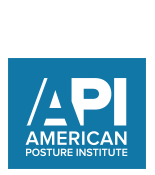
Top Posture Correction Protocol for Athletes
It is estimated that currently 70% of amateur athletes suffer from postural distortions. These statistics are absolutely astonishing! This means that 70% of aspiring athletes are training and competing with a decreased functional capacity of their body and with improper form making them more susceptible to preventable injuries.
The American Posture Institute has created a Program for athletes called FITPosture. This program implements API’s principles to posture correction: Spinal Alignment, Postural Rehabilitation, and Posture Habit Re-Education. The program is a 360-degree approach to enhancing performance and preventing injury.
For todays blog we will explain 3 key areas of focus when working on an athlete. Most common target areas for injuries in athletes lay in the shoulders and lower extremity including knee and ankle injury as well as pulled muscles of the legs. Furthermore a common performance inhibiting factor is minimized oxygen intake.
3 Ways to Improve Athletic Performance and Prevent Injury Through Postural Correction
Scapular stabilization: The most common shoulder injuries are due to chronic over use, or unstable positioning during activity. With one exercise you can help to improve both of these. Scapular stabilization limits one of the major factors causing both of these types of injuries.
Due to weak scapular stabilization the shoulders normal range of motion is altered opening the doorway for chronic over use injury. In addition with weak scapular stabilizers the shoulder often is in weak or unstable positions allowing for traumatic injury to occur. Incorporating Scapular Strengthening and stabilization exercise improves greatly the function of the shoulder, preventing injury from occurring.
Pelvic Leveling: With pelvic un-leveling the positioning of the joints of the lower extremity is altered putting the ankle and knee in vulnerable positions. When quick motions are needed, or high strain and impact is occurred these posture distortion patterns or faluty positioning of the lower extremities causes trauma to the joints. These traumas are most often ligamentous damage such as Torn ACL, or rolled/sprained/strained ankles, as well as meniscus damage. Furthermore when the legs have these postural distortion patterns due to unleveling of the pelvis the entire kinetic chain is altered, effecting muscular function. With altered movement patters lengthened muscles compensate being open to tears or strains, while shortened muscle patterns are inhibited causing decreased performance.
The solution to trauma free and high performance of the lower extremity is correct pelvic alignment. To check if the pelvis has a postural distortion pattern, perform a leg length analysis of the athlete. Lay the athlete face down and then using your thumbs apply gentle pressure superior in the heels. Looking from directly over top of the heels see the heel positioning. Correct pelvic alignment would have even heel placement. A postural distortion pattern would have one heel slightly or greatly lower/higher than the other.
Respiration and Endurance: A fundamental key to performance is proper oxygenation, or respiration. With postural distortion patterns of the thoracic spine the ribs are shifted forward and inferior. The muscular connections are altered, and the lungs are inhibited. This decrease in lung function, decrease respiration, limiting oxygen intake. This causes fatigue, and minimized endurance.
To increase respiration and performance through oxygen intake ensure that the thoracic spine is posturally stable with no postural distortion patterns by performing the Spinal Push Test. If any points of postural instability are located these would then be immediately corrected through the CPC Protocol (Complete Posture Correction). This correction would be immediate and allow the athlete to perform with proper respiratory function due to correct posture.
These are three key concepts to keeping an athlete in optimal human performance while limiting the chances for injuries due to postural distortion patterns. Postural correction is a winning strategy for athletes!

















